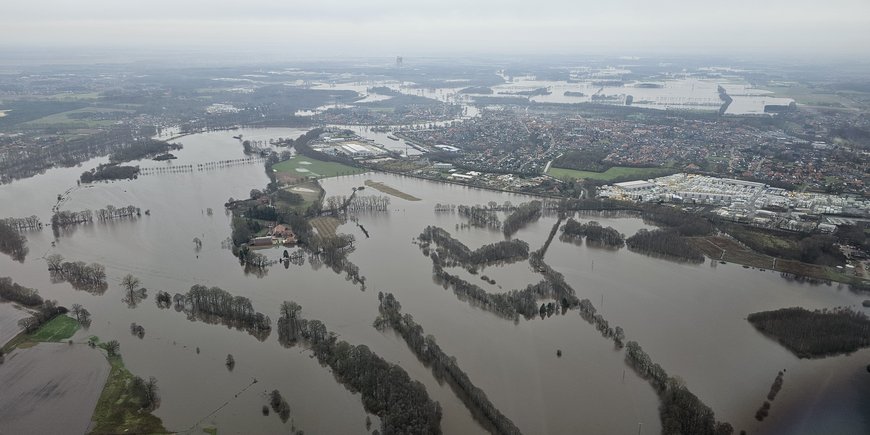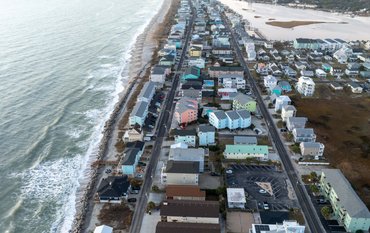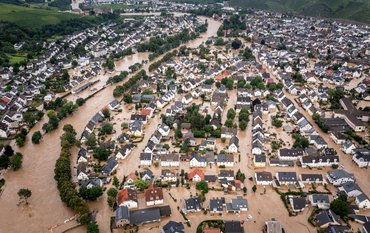For the past two weeks, Germany has been affected by prolonged and very extensive flooding, with critical situations almost throughout the country.
Bruno Merz, Head of Section 4.4 “Hydrology” and Professor at the University of Potsdam, and Sergiy Vorogushyn, Senior Scientist in Section 4.4, provide answers to important questions about the causes and the challenges and current status of flood protection and risk management.
How did this extreme flood situation come about and what is special about it?
The flood situation was triggered by a series of low-pressure systems that brought moist air from the Atlantic to north-west Europe one after the other. According to Germany's National Meteorological Service Deutscher Wetterdienst (DWD), December 2023 was one of the 10 wettest months since 1881. In Lower Saxony, North Rhine-Westphalia and Saxony-Anhalt, there was twice as much precipitation in December as the long-term average. As a result, the soil became saturated over the course of December, meaning that any additional rainfall ran off directly and contributed to the flooding situation. The long duration and the large spatial extent pose an enormous logistical challenge. Our research shows a strong positive trend in the spatial extent of floods in recent decades, i.e. floods tend to affect larger regions at the same time (Kemter et al., 2020).
Kemter, M., Merz, B., Marwan, N., Vorogushyn, S., & Blöschl, G. (2020). Joint Trends in Flood Magnitudes and Spatial Extents Across Europe. Geophysical Research Letters, 47(7), e2020GL087464. doi:10.1029/2020gl087464
How does this compare with the Ahr Valley disaster?
The current flood is a typical winter flood and shows some differences to the Ahr flood in July 2021. Winter floods build up more slowly, last longer and are typically triggered by saturated soils and abundant, but not necessarily extreme, precipitation. Snowmelt often also plays a role. Summer floods, on the other hand, are triggered by extreme amounts of rainfall in a short period of time. They are also more spatially limited and occur more quickly. In the summer of 2021, the very rapid reaction of brooks and smaller rivers was a major problem. Water levels rose dramatically within just a few hours.
Have such extreme events become more frequent in recent years or decades?
Yes, in a large study (Blöschl et al., 2019), we worked with other scientists to analyse the changes in flood peaks in Europe over the last 50 years. For north-west Europe and central Europe, we found predominantly increasing trends, i.e. the flood peaks have become significantly larger over the last few decades and this is due to climate change.
Blöschl, G., Hall, J., Viglione, A., Perdigão, R. A., Parajka, J., Merz, B., ... & Živković, N. (2019). Changing climate both increases and decreases European river floods. Nature, 573(7772), 108-111. DOI: 10.1038/s41586-019-1495-6
What role does climate change play? And what can we expect for the future? Should we expect more frequent or even worse events in the future?
The trends in flood peaks can be explained by changes in climatic variables. For large parts of Germany, the flood trends run parallel to the trends in multi-day heavy precipitation. For example, heavy precipitation over 7 days in winter has increased everywhere in Germany, in some cases by up to 40% (Murawski et al., 2015).
Murawski, A., Zimmer, J., & Merz, B. (2015). High spatial and temporal organisation of changes in precipitation over Germany for 1951-2006. International Journal of Climatology. doi:10.1002/joc.4514
In future, we will have to expect more frequent or even worse events. Warmer air can absorb more water vapour, so that more water is available to rain down in the atmosphere. Milder winters also mean a higher snowfall threshold. A larger proportion of winter precipitation falls as rain instead of snow. This precipitation is then not stored in the landscape, but runs off directly. There are also changes in atmospheric flow patterns. For example, intensive research is being carried out into the extent to which climate change leads to longer periods of extreme weather patterns.
What are the biggest challenges in flood protection and risk management? Especially for large-scale situations like now? How can we be well prepared?
The current situation is a logistical challenge for civil protection. In order to manage such situations well, the emergency services and those affected need fast and reliable information about what is likely to be flooded and when. Germany has a well-organised flood forecasting system. However, these forecasts provide water levels at river gauges, and it is not easy for disaster management and those affected to interpret this information and derive actions. Should a settlement be evacuated or not if a critical water level is predicted at a river gauges 10 kilometres upstream?
This is where the current research field of impact forecasting comes in, which is intended to help both with flood disasters such as those in the Ahr valley and with large-scale flood situations. Models are being developed here that transfer water level predictions to the area. This means predicting which areas are likely to be flooded, when and at what water depth, and which objects, settlements and critical infrastructure will be affected (Apel et al., 2022).
For example, we can use our models to quickly simulate what would happen if a dyke would break and which buildings, roads or hospitals and critical infrastructure could be affected and how. Such information can only be derived to a limited extent from the existing flood hazard maps because every flood has its own particularities. Flood control centres could use such models to quickly simulate special situations, such as potential dyke breaches, and thus provide better support for evacuation operations and logistics.
Apel, H., Vorogushyn, S., & Merz, B. (2022). Brief communication: Impact forecasting could substantially improve the emergency management of deadly floods: case study July 2021 floods in Germany. Nat. Hazards Earth Syst. Sci., 22(9), 3005-3014. doi:10.5194/nhess-22-3005-2022.
Is this all still research or will such systems for ad-hoc simulation soon be available in practice?
The first prototypes have been implemented in practice. One challenge of impact prediction is the greater uncertainty compared to water level predictions at gauging stations. The extent of these uncertainties and how they need to be communicated are being investigated together with practitioners.
How well are flood protection and risk management in Germany generally prepared for such events? Are the dykes sufficiently high and strong?
Over the past two decades, a lot has been invested in technical flood protection; dykes have been upgraded and new retention areas created. After the June floods in 2013, the National Flood Protection Programme was adopted and is currently being implemented. These investments are now having a positive effect. However, technical flood defences cannot protect against every event. Dykes are built for a specific protection goal; for example, they are designed to protect against the 100-year flood – this is a flood that occurs on average every 100 years or with a probability of 1:100 every year. If a significantly larger flood occurs, the dyke will be overtopped and very likely break. We have to deal in advance with situations in which technical protection systems are overwhelmed, partly because climate change is expected to increase the frequency of such events.
What have we learnt from the Ahrtal disaster, for example?
One realisation concerns the important role of critical infrastructure. In July 2021, important infrastructures such as power supply, mobile communication and water supply failed. We need to think through situations in advance in which our technical protection systems are overwhelmed. Would the power supply be jeopardised? If so, what other consequences would a power failure have? Where are the key weak points and how can we mitigate them?
In the KAHR (Climate Adaptation, Floods and Resilience) project, which is funded by the Federal Ministry of Education and Research and in which the GFZ is involved, the reconstruction in the regions affected by the flood disaster 2021 is being scientifically monitored. The aim is to contribute to flood risk management and enable the development of resilient and climate-adapted solutions.
https://www.hochwasser-kahr.de/index.php/en/
What needs to be improved in terms of protection and prevention measures if such – possibly also long-lasting – flood events occur more frequently in the future, especially long-lasting, widespread events like the one we are experiencing now? Where can the local authorities, the federal states and the federal government take action?
If large-scale flooding situations like this year occur more frequently in the future, thousands of emergency personnel will be on permanent duty more often. A lot of equipment and material will have to be transported and deployed - sandbags, mobile dykes, etc. This is above all a logistical challenge. Risk management would then have to strengthen the logistical infrastructure, increase stocks of equipment and materials and deploy them more widely, and be able to call on more well-trained emergency personnel.
In general, it is important to increase flood awareness and knowledge of protective measures. We see that risk awareness in the affected regions is high in the months and even several years after severe flood events. However, this awareness fades if there are no floods in a region for a longer period of time. This is referred to as "flood dementia". It therefore remains a challenge to maintain risk awareness even in times of low flooding, because the next flood is sure to come.
In addition, our research shows that those affected only react well if they know what to do in the event of a flood. For 20 years, we have been asking people whose homes or businesses have been flooded after major floods: Those who have been aware of their risk and possible protective measures in advance can significantly reduce damage; while others who only get the forecast but have not thought about such situations fail to do so (Kreibich et al., 2021).
Kreibich, H., Hudson, P., & Merz, B. (2021). Knowing What to Do Substantially Improves the Effectiveness of Flood Early Warning. Bulletin of the American Meteorological Society, 102(7), E1450-E1463. doi:10.1175/bams-d-20-0262.1











![[Translate to English:] Group photo with 7 people in front of a new metal plant in a large laboratory hall.](/fileadmin/_processed_/0/4/csm_20240628-GFZ_Einweihung_Triax-Anlage-PRESSE_Abb1_040_c-Bahlo-GFZ_187906cb48.jpeg)




![[Translate to English:] Heidi Kreibich, woman with short brown hair and blue eyes. She is wearing a grey cardigan and a red polo shirt](/fileadmin/_processed_/6/6/csm_kreibich-Heidi_1_Querformat_he-2021_2dedd3ef33.jpeg)




![[Translate to English:] [Translate to English:] Totes Meer gesehen von einem Hügel am Ufer](/fileadmin/_processed_/0/f/csm_20240612-web_AdobeStock_151245578_cb8e2706f3.jpeg)




![[Translate to English:] Gruppenfoto im Hörsaal](/fileadmin/_processed_/8/a/csm_240528-GfZ-ERC-Grantees-Gruppe_31be9704f5.jpeg)
![[Translate to English:] Susanne Buiter in front of a blue wall with GFZ logo](/fileadmin/_processed_/d/7/csm_20220721-GFZ-Portrait-Buiter-1-he-web_-c-Reinhardt_Sommer_2a6e3b8ae1.jpeg)
![[Translate to English:] [Translate to English:] Drohne](/fileadmin/_processed_/b/a/csm_20240515_155801_d696ee4200.jpeg)



![[Translate to English:] ein riesiges Erdloch in einer kargen Landschaft im Iran mit Bergen im Hintergrund](/fileadmin/_processed_/f/1/csm_DSC_7917_kleiner_f14e27f7ad.jpeg)

![[Translate to English:] Lecture room at GFZ with participants](/fileadmin/_processed_/a/9/csm_P1140796__002__c03fcad8bd.jpeg)

